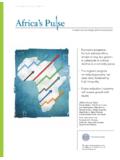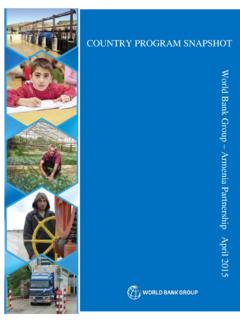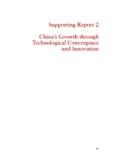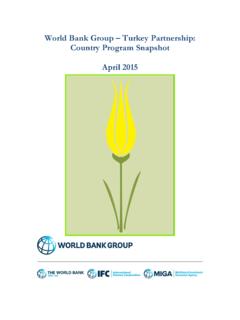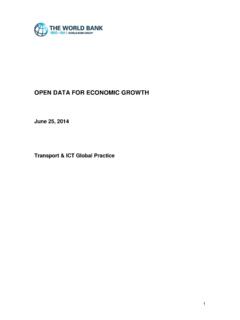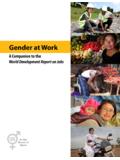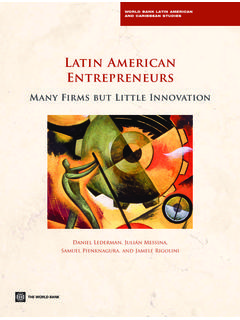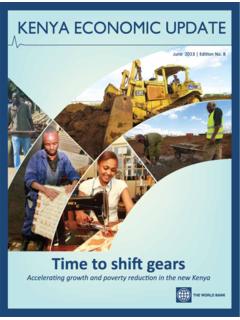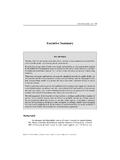Transcription of Indonesia Sanitation Report - World Bank
1 THE World BANKSEPTEMBER 2013 DisclaimerThe views expressed in this publication are those of the authors and not necessarily those of the Australian Agency for International Development (AusAID)iTable of ContentsAcknowledgments .. iiiAbbreviations and Acronyms .. vExecutive Summary .. vii1 Overview of the urban Wastewater Management Sector in Indonesia .. Background .. Sanitation Policy .. Wastewater Management Technology .. Social Considerations .. 8 Institutional Arrangements for Sanitation .. 92 Sector Performance Issues Analysis .. Drivers and Barriers to Sanitation in Indonesia .. Current Drivers to Sanitation Development in Indonesia .. Current Barriers to Sanitation Development in Indonesia .. Key Issues Impacting on Sanitation Provision in Indonesia .. Political Economy .. Financing .. Implementation Capacity.
2 Management and Regulation of Sanitation Systems .. The Interface between Community-managed and Institutionally-managed Services .. Septage Management .. 243 Recommendations .. Policy Recommendations .. Institutional Recommendations .. Technology Recommendations .. People Recommendations .. Financing Recommendations .. 35iiURBAN Sanitation REVIEW: Indonesia COUNTRY STUDYANNEXES .. 37 Annex 1: Sector Performance in Indonesia .. 39 Annex 2 City Case Studies .. 41 Annex -- Case Study: Banjarmasin Municipality .. 43 Annex -- Case Study: Medan Municipality .. 45 Annex -- Case Study: Surakarta Municipality .. 47 Annex -- Case Study: Palembang Municipality .. 50 REFERENCES .. 51 BOXESBox Comparison of Indonesian Experience with that of Selected Latin American Countries .. 16 Box Political Economy of Sanitation in Indonesia .
3 18 Box Investment in Indonesia s Water Sector .. 19 Box Decentralized Sewerage Systems in Malang .. 25 FIGURESF igure 1: Wastewater and Septage Flow in urban Indonesia .. viiiFigure : History of Sanitation Development in Indonesia .. 2 Figure : Individual, Community and Institutional-based Sanitation Approaches .. 4 Figure : Wastewater and Septage Flow in urban Indonesia .. 6 Figure : Total National Government Sanitation Budget (2006-2012) .. 8 Figure : Weaknesses in Local Government Sanitation Service Delivery .. 17 Figure : Proposed Arrangements for Local Governance of Sanitation Systems .. 22 TABLEST able : Sewerage Systems in Indonesia .. 2 Table : Sewerage Coverage in Asia .. 3 Table : Projected Financing Allocations for Sanitation .. 9 Table : Indonesia urban Wastewater Sector Performance .. 39 Table : Overview of Select urban Centers in Indonesia .
4 41iiiAcknowledgmentsThis country Report on Indonesia provides the background for the urban Sanitation Review for the East Asia and Pacif-ic Region. The country Report was prepared through a con-sultative process in Indonesia which included meetings with central and local government authorities, review of Sanitation operations in the cities of Medan, Surakarta, Palembang, and Banjarmasin, and a workshop that was held in Jakarta on Feb-ruary 21, 2013. This Report has been prepared with the fi nan-cial support of an AusAID grant. The Task Team Leader (TTL) for this task is Sudipto Sarkar and the Sector Managers for the product are Charles Feinstein and Nathan Belete. The previous TTL was Alan Coulthart. The main author of this Report is Ross Kearton (consultant) and inputs have been provided by the following staff from the bank and the Water and Sanitation Program (WSP): Victor Vazquez Al-varez, Irma Magdalena Setiono, George Soraya, Fook Chuan Eng, Richard Pollard, Demilour Reyes Ignacio, Almud Weitz, Eduardo Perez, Alexander Danilenko, and Isabel Blackett.
5 Im-portant contributions were also made by a team of consul-tants, including: Enrico Rahadi Djonoputro, Risyana Sukarma, Eric Buhl-Nielsen, and Mara Baranson. The peer reviewers for this Report were Eduardo Perez and Michael John task team for this Report greatly appreciates the technical contributions made by the various stakeholders who were consulted during the preparation of the Report and the fi nan-cial support provided by Sanitation REVIEW: Indonesia COUNTRY STUDYvAbbreviations and AcronymsADB Asian Development BankAKKOPSIA sosiasi Kabupaten Kota Peduli Sanitasi (Association of Cities and Districts Concerned about Sanitation )AMPLAir Minum dan Penyehatan Lingkungan(National Steering Committee for Drinking Water and Environmental HealthAPBDA nggaran Pendapatan Belanja Daerah (Local Government Budget)APBNA nggaran Pendapatan Belanja Negara (National Budget Funding)AusAID Australian Agency for International DevelopmentBAPPEDAB adan Perencanaan Pembangunan Daerah(Regional Agency for Planning and Development)BAPPENASB adan Perencanaan Pembangunan Nasional (National Development Planning Agency)BLHB adan Lingkungan Hidup (Local Environmental Agency)BLUDB adan Layanan Umum Daerah (Local Service Delivery Agency)BPLHDB adan Pengendalian Lingkungan Hidup Daerah(Provincial Environmental Agency))
6 BOD Biological Oxygen DemandBORDA Bremen Overseas Research and Development AssociationCipta Karya Directorate General of Human SettlementsDAKDana Alokasi Khusus (Special Budget Allocation for Local Government)DEWATS Decentralized Wastewater Treatment SystemsDKDinas Kebersihan (City Cleaning Department)GDP Gross Domestic ProductGOI Government of IndonesiaHIS Health Information SystemIDB Islamic Development BankIDR Indonesian RupiahIPLTI nstalasi Pengolahan Lumpur Tinja (Septage Treatment Plant)ITBI nstitut Teknologi Bandung (Bandung Institute of Technology)IUIDP Integrated urban Infrastructure Development ProgramIUWASH Indonesia urban Water, Sanitation and Hygiene ProjectISSDP Indonesia Sanitation Sector Development ProgramJICA Japan International Cooperation AgencyJMP Joint Monitoring ProgramJWSRB Jakarta Water Supply Regulatory BodyKLHK ementerian Lingkungan Hidup (Ministry of Environment)MCK/MCK+Mandi Cuci Kakus (communal toilets)/MCK + primary treatment systemMDG Millennium Development GoalsMLD Megaliters (or Million Liters) Per DayMOF Ministry of FinanceMOH Ministry of HealthMOHA Ministry of Home Aff airsMPW Ministry of Public WorksMSMIP Metropolitan Sanitation Management Investment ProjectNGO Non-Government OrganizationODF Open Defecation FreeO&M Operation and MaintenancePDAMP erusahaan Daerah Air Minum (Local Government Owned Water Utility)PD PALP erusahaan Daerah Pengelolaan Air Limbah (Local Government Owned Wastewater Utility)
7 POKJA Working GroupPPPeraturan Pemerintah (Government Regulation)viURBAN Sanitation REVIEW: Indonesia COUNTRY STUDYPPP Public Private PartnershipsPPSPP rogram Percepatan Pembangunan Sanitasi Perkotaan (Road Map for Acceleration of urban Sanitation Development)PROKASIHP rogram Kali Bersih (Clean River Program)PROPER Program for Pollution Control Evaluation and RatingRBC Rotating Biological ContactorRPJMNR encana Pembangunan Jangka Menengah Nasional (Medium Term Development Plan)sAIIG Australia Indonesia Grant for SanitationSANIMASS anitasi Oleh Masyarakat ( Sanitation by Communities)SDO Service Delivery OrganizationSKPDS atuan Kerja Perangkat Daerah (Regional Working Unit)SS Suspended SolidsSSK City Sanitation StrategySTBMS anitasi Total Berbasis Masyarakat (National Strategy for Community Based Total Sanitation )UASB Upfl ow Anaerobic Sludge BlanketUNICEF United Nations Children s FundUPTD Unit Pelaksana Teknis Daerah (Regional Technical Implementation Unit)
8 USAID United States Agency for International DevelopmentUSD US Dollar currencyUSDP urban Sanitation Development ProgramWASPOLA Water and Sanitation Sector Policy Formulation and Action Planning ProjectWHO World Health OrganizationWSP Water and Sanitation ProgramWWTP Wastewater Treatment PlantviiExecutive SummaryThe Executive Summary is organized into three sections: Sec-tor Performance Overview, Sector Analysis (covering people aspects, technology, governance, and fi nance), and Recom-mendations. A. Sector Performance OverviewThis Indonesia Country Study forms part of the East Asia urban Sanitation Review. The Review focuses on three of the emerging middle income countries of East Asia: Indone-sia, Philippines and Vietnam. The Reviewwill develop a region-al strategic framework to help guide national urban Sanitation programs and their implementation in these emerging mid-dle income half of Indonesia s population of 245 million peo-ple lives in urban areas and their need for safe wastewa-ter management services are growing rapidly.
9 The majori-ty of urban households and businesses in Indonesia use septic tanks for wastewater disposal, and the use of water-fl ush toi-lets is common. About 14 percent of urban dwellers still prac-tice open defecation. Although access to improved Sanitation in urban Indonesia was about 73 percent in 2010, this only considers the basic criteria of access to a facility as defi ned by the World Health Organization (WHO) Joint Monitoring Program (JPM) and not safe collection and disposal of waste-water and septage, which is only 1 percent and 4 percent, re-spectively. This coverage is signifi cantly lower than in other East Asian countries despite Indonesia having experienced signifi cant economic growth in recent years, surpassing many of its neighboring countries. The economic impacts of poor sanitation1 in Indonesia are signifi cant. A study carried out by the World bank s Water and Sanitation Program estimates that Indonesia lost IDR56 trillion ( billion) in 2007 due to poor Sanitation and hygiene, equivalent to about percent of the country s gross domestic in 2000, the central government, coordinated by BAPPENAS,2 embarked on a series of initiatives to re-form water supply and Sanitation sector policies.
10 These reforms were aligned with decentralization which devolved responsibility for Sanitation to the local government. The fol-lowing has been achieved: establishment of the Acceleration of urban Sanitation De-velopment Program (PPSP) to assist local governments in comprehensive citywide Sanitation planning through the preparation of City Sanitation Strategies (SSK). As of mid-2012, 240 cities and regencies have prepared SSKs, and 330 of the 496 local governments in Indonesia are expected to complete them by 2014; inclusion in the 2010-2014 Medium Term Development Plan of Sanitation targets: (a) Indonesia to be 100 percen-tOpen Defecation Free; (b) 10 percent of the total popula-tion to be using off -site wastewater management systems; and (c) 90 percent of the population to have improved on-site or shared facilities; a total of approximately 1700 decentralized wastewater treatment systems (DEWATS) constructed countrywide with another 4,000 DEWATS systems planned to be imple-mented by 2015.

